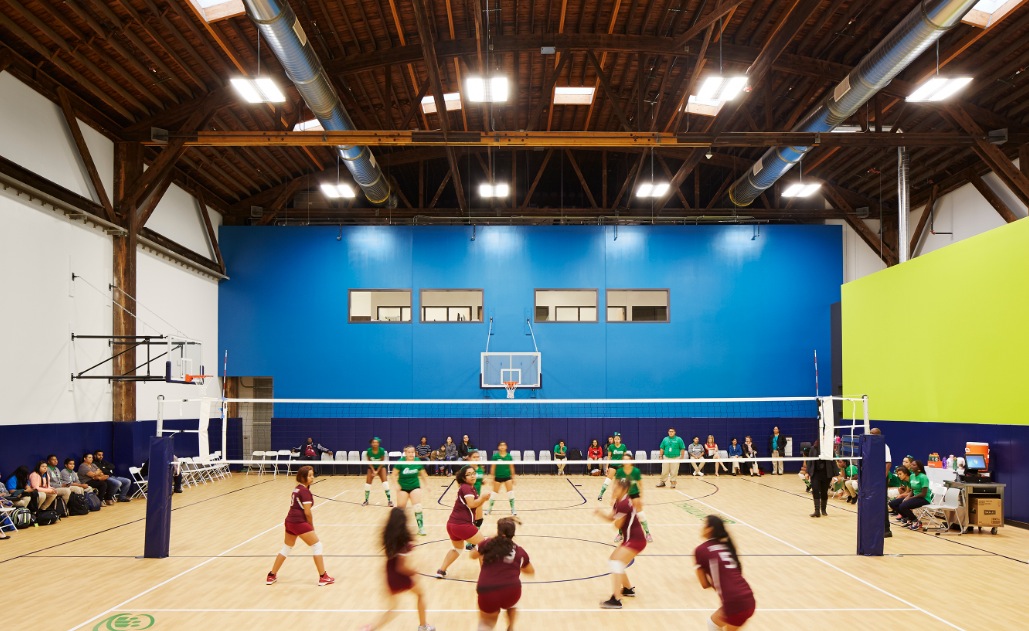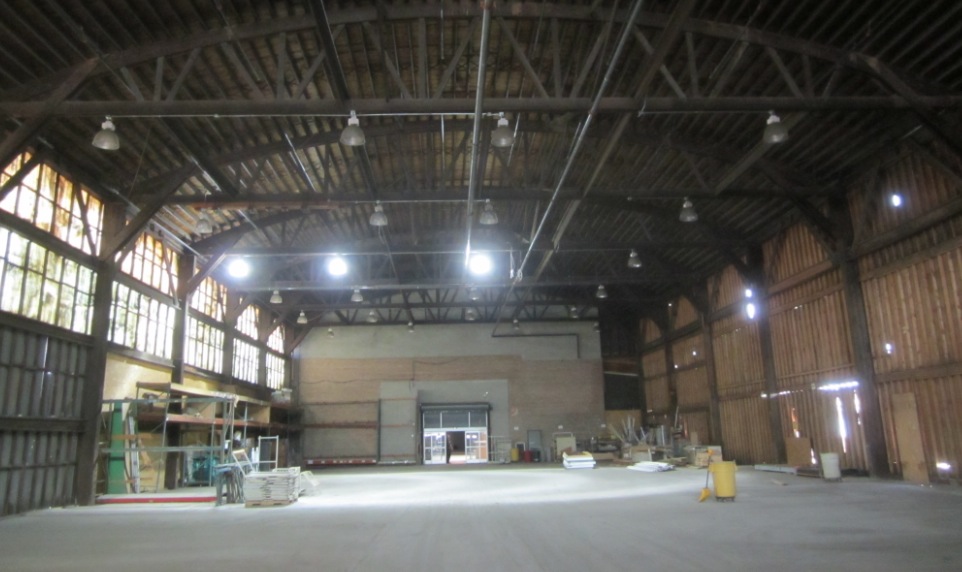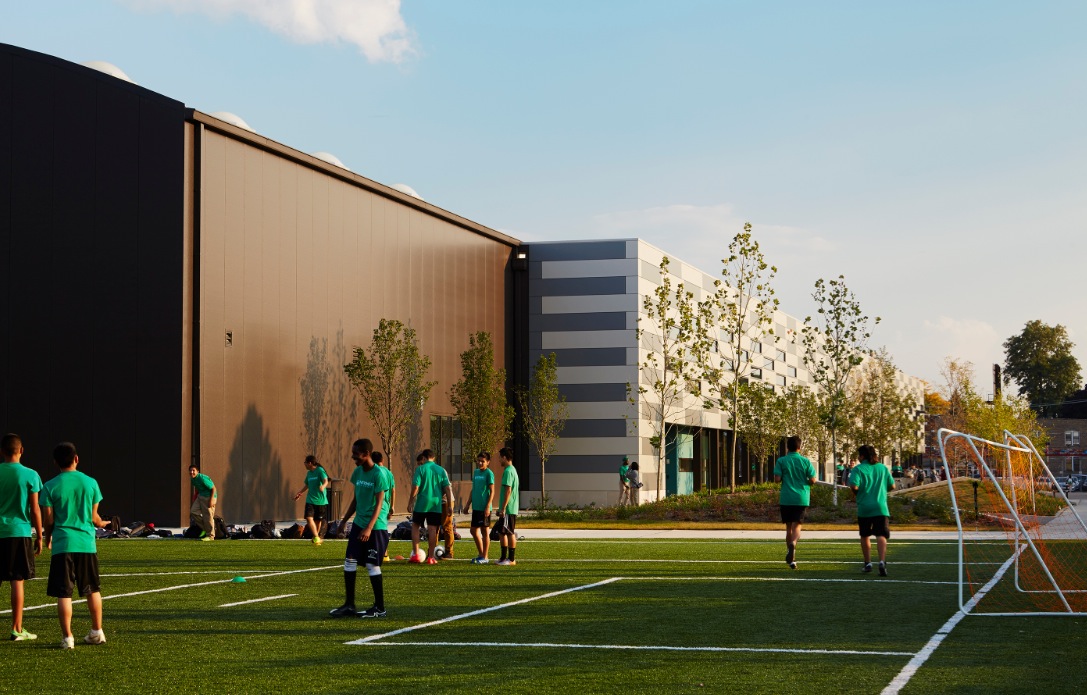One of the more unusual adaptive reuse efforts you’ll see, the Intrinsic School project involved converting a series of lumberyard structures on Chicago’s Northwest side into a grade 7-12 public charter school.
The client desired large, column-free spaces to accommodate its blended learning-based curriculum. The teaching model—which combines teacher-led instruction with peer-to-peer learning and individualized software-based learning—called for a series of highly adaptable, pod-like spaces in lieu of traditional classrooms.
GOLD AWARD
INTRINSIC SCHOOL | Chicago, Ill.
Building Team
Submitting firm: Wheeler Kearns Architects (architect)
Structural engineer: Enspect Engineering
Civil engineer: Terra Engineering
MEP engineer: McGuire Engineers
Acoustical consultant: Threshold Acoustics
Landscape architect: Wolff Landscape Architects
Program manager: RMC International
General contractor: Clune ConstructionGENERAL INFORMATION
Size: 58,234 sf
Construction time: February 2014 to August 2014
Cost: Confidential at owner’s request
Delivery method: Design-bid-build
The lumberyard, with its three voluminous buildings, each with column-free spaces and exposed bowstring truss roofs, was a viable solution for the new school.
While the existing structures, originally built between 1911 and 1955, were in poor condition, the Building Team was able to preserve and restore 75% of the spaces and incorporate the historic elements in the final design. Many of the original wood columns and beams were left exposed, as were the bowstring roof trusses and brick walls, to create a visual connection to the buildings’ industrial past.
Reusing the original elements posed a special set of obstacles. The restoration of the bowstring trusses required special permits. In the pod for ninth graders, the team had to rebuild the top cords for the trusses, and steel rods were placed at the bottom of the trusses to reduce the tension load. In the atrium, the massive wood columns required steel “splints” for structural reinforcement.
The buildings’ existing brick walls and built-up roofs were wrapped in an insulated metal panel façade system and a new spray foam roof to create a super-insulated, moisture-resistant exterior. Rather than landfilling the built-up roofs, the spray foam system was applied directly over the existing roofs.
Inside, the team employed a “ship in a bottle” approach: a two-story steel-framed structure was constructed within a single-story shed. To delineate the various learning spaces within the pods, the team specified carpet tile in differing patterns and incorporated landmark design elements. The peer-to-peer learning areas, for instance, feature oversized light fixture shades fabricated from a felt-like material made from recycled milk jugs.
A combination of clerestory windows, storefronts, aerogel-filled skylights, picture windows, and interior glass floods the interior spaces with natural light. High-efficiency fluorescent fixtures provide supplemental lighting.
Since the existing roof structures were not capable of supporting vegetated green roofs, the city of Chicago permitted an alternative plan that diverts twice as much rainwater from the city’s sewers than a vegetated roof scheme would have rerouted. Once entirely paved, the site is now 72% pervious, excluding the building footprint. Two large aggregate water detention areas are located below the turf field and the vehicular drop-off loop.
 The Building Team was able to reuse three-quarters of the existing lumberyard structures, and incorporated many of the original elements in the final design. The most dramatic example is in the multipurpose room/gymnasium, where the existing bowstring trusses and wood columns were left exposed. Photos: Steve Hall, Hedrich Blessing (after); Wheeler Kearns (before).
The Building Team was able to reuse three-quarters of the existing lumberyard structures, and incorporated many of the original elements in the final design. The most dramatic example is in the multipurpose room/gymnasium, where the existing bowstring trusses and wood columns were left exposed. Photos: Steve Hall, Hedrich Blessing (after); Wheeler Kearns (before).

SUPPORTING 21ST-CENTURY LEARNING
Since Intrinsic’s students use Chromebooks, there was no need for lockers. The ubiquitous double-loaded school corridor is replaced by a hallway lined with windows and views connecting all six tandem pods.
Instead of individual classes managed by a single teacher, groups of up to eight teachers and 180 students navigate within an interconnected tandem pod. Half of the pod is dedicated to science, technology, and math, the other half to humanities. Both students and teachers rotate through different modes of learning hosted in purposefully designed spaces. Students only use the hallway to travel to lunch, physical education, and special co-curricular activities.
Each pod contains a mix of work areas and furniture, and is divided into five distinct zones: The Exchange (for group projects), The Genius Bar (one-on-one instruction), The Coastline (individual work), The Pop-Up Class (teacher-led instruction), and The Ocean (study lounge).
Instead of diminishing the teacher’s role with technology, Intrinsic enables a more effective use of their time and talent. Since teachers get real-time data on student achievement, students struggling with the same concept can be recruited for small group lessons tailored for them. Similarly, teachers can group students who just successfully navigated new material to reinforce critical concepts.
CREATING A NEIGHBORHOOD AMENITY
To encourage after-hours’ use of the school’s facilities by local community groups, the Building Team created a separate entry vestibule for shared spaces, such as the multipurpose room, locker rooms, kitchen, and practice field. Access is controlled using a digital fob system that can be set to activate and deactivate at predetermined times. The school’s artificial turf field is permanently lined for youth soccer. Unlike most urban high schools, Intrinsic is not walled-in by a perimeter fence.
By opening its facility to the neighborhood, Intrinsic encourages local families to get acquainted with its mission before their children reach seventh grade.
 Intrinsic School's artificial turf field is permanently lined for soccer. Photo: Steve Hall, Hedrich Blessing.
Intrinsic School's artificial turf field is permanently lined for soccer. Photo: Steve Hall, Hedrich Blessing.
Related Stories
Reconstruction Awards | Jan 6, 2021
University of Pennsylvania’s Stemmler Hall forgoes retrofit in favor of complete renovation
The Edward J. Stemmler Hall project has won a Bronze Award in BD+C’s 2020 Reconstruction Awards.
Reconstruction Awards | Dec 29, 2020
The reenvisioned Sazerac House: A delectable cocktail that's just perfect for the Big Easy
The 51,987-sf Sazerac House is an interactive cocktail museum, active distillery, corporate headquarters, and event venue, all under one roof, next to the historic French Quarter of New Orleans.
Reconstruction Awards | Dec 18, 2020
Can converting a landmark office to a clinic raise up a downtrodden Philadelphia neighborhood?
BD+C’s Reconstruction Awards recognize the adaptive reuse of the Kensington Trust building.
Reconstruction Awards | Dec 18, 2020
Spokane Riverfront Park U.S. Pavilion project creates a refreshed gathering place in Spokane
The project has won a Bronze Award in BD+C's 2020 Reconstruction Awards.
Reconstruction Awards | Dec 16, 2020
Voters resuscitate an abandoned high school in northern California
A 2014 bond issue provided financing to seismically stabilize and modernize Historic Alameda High School, a 2020 Silver Reconstruction Award winner.
Reconstruction Awards | Dec 14, 2020
Wyoming Capitol Square renovation project is all about the details
The Wyoming Capitol Square project has won a Gold Award in BD+C's 2020 Reconstruction Awards.
Reconstruction Awards | Dec 12, 2020
A famed dome of a historic glasshouse is revived to its rightful glory
Scaffolding played a critical role in the repair and restoration of the Enid A. Haupt Conservatory’s Palm Dome at the New York Botanical Gardens, a Gold winner of BD&C’s 2020 Reconstruction Awards
Reconstruction Awards | Dec 8, 2020
A synagogue in Toronto is renewed while preserving its history
Holy Blossom Temple is a Platinum winner in BD+C’s 2020 Reconstruction Awards.















